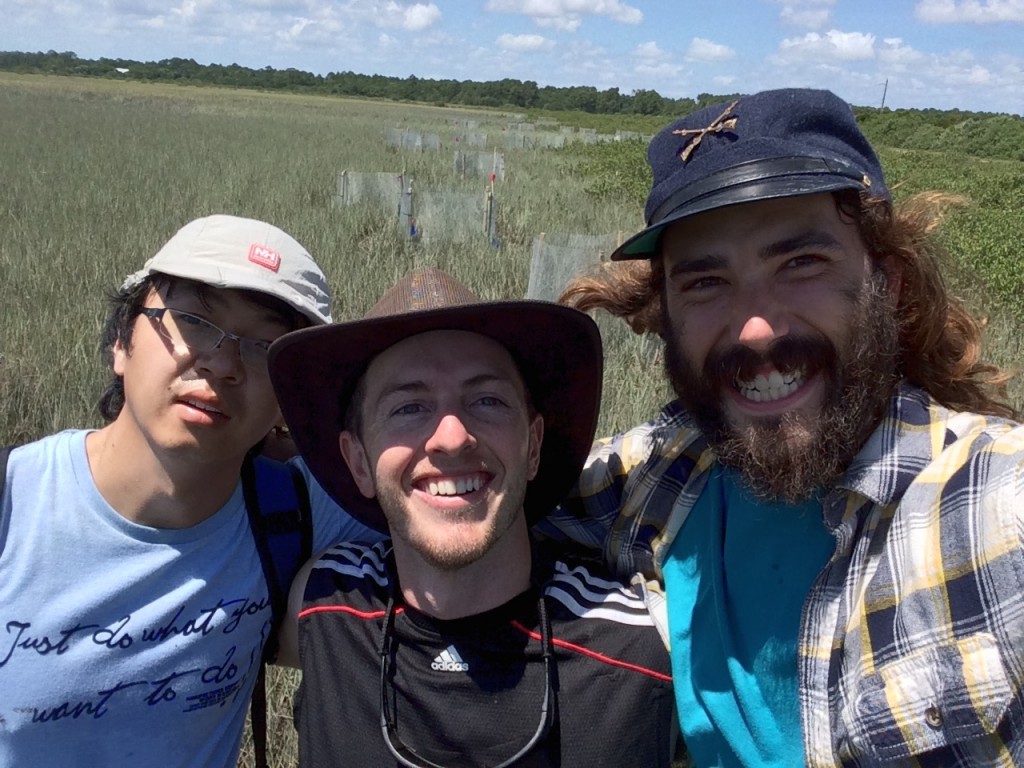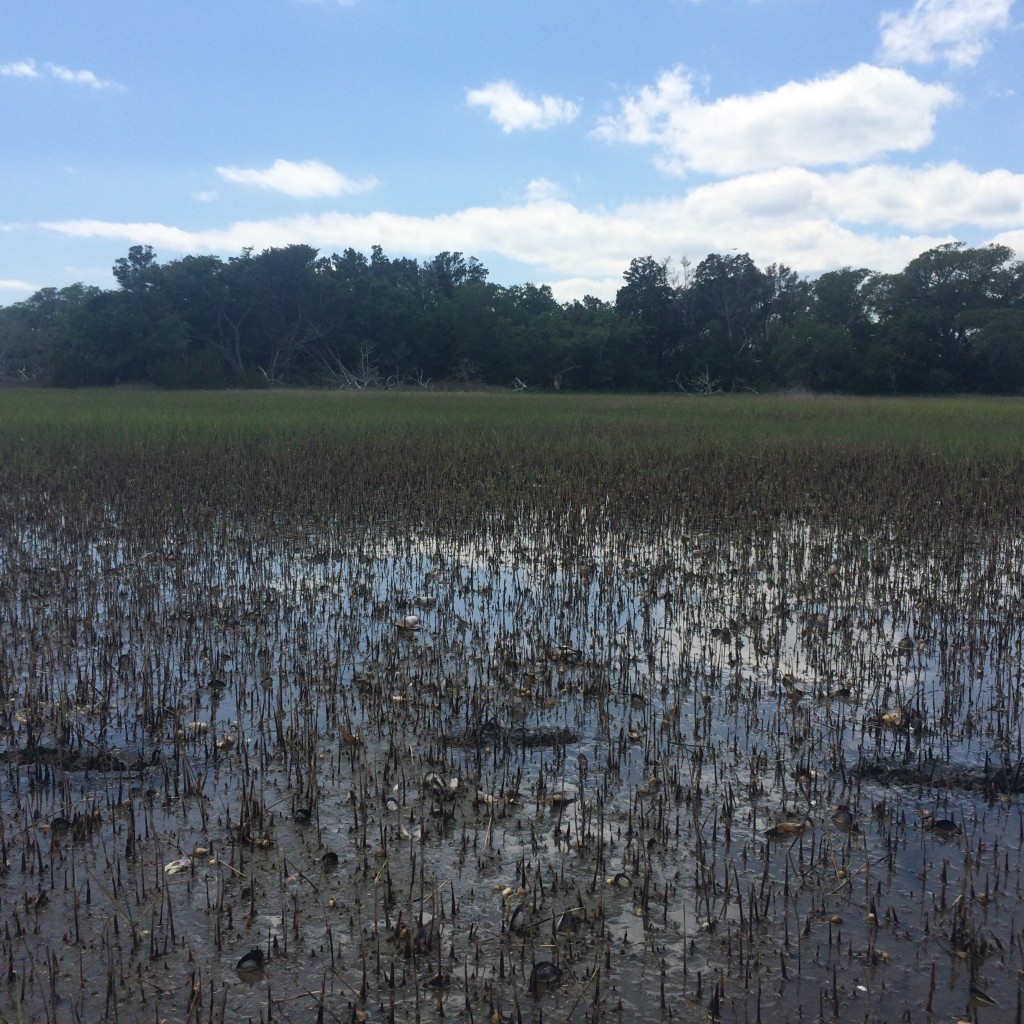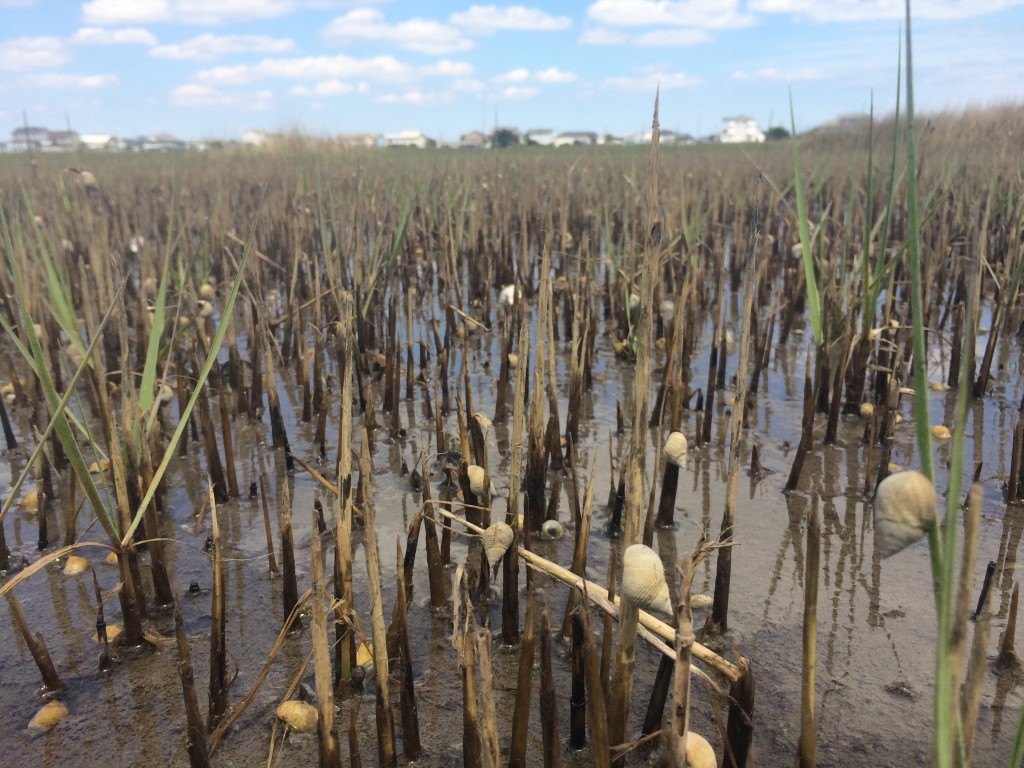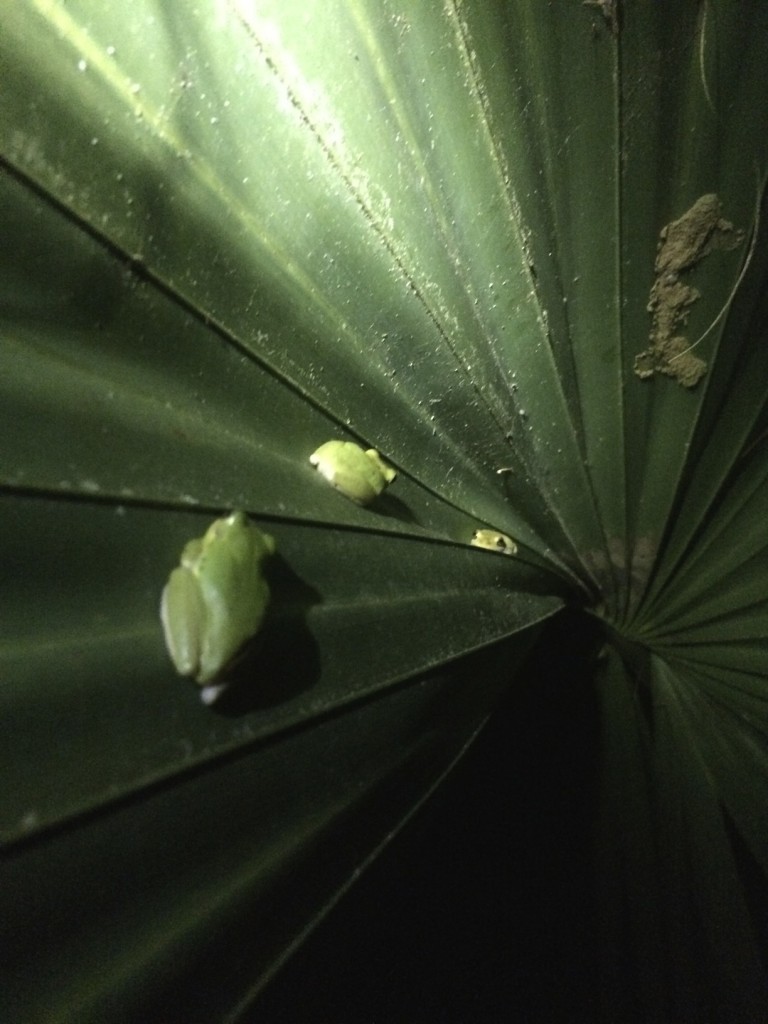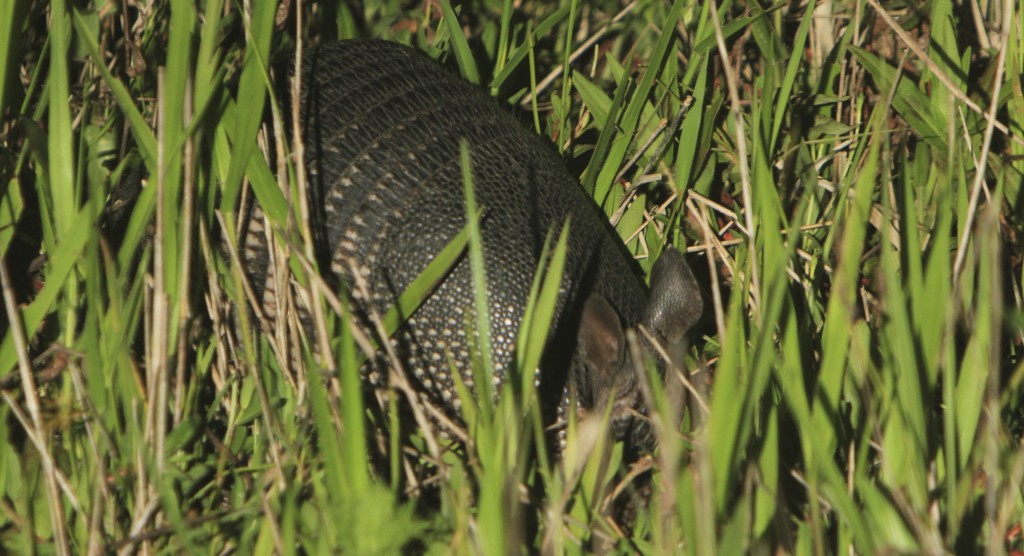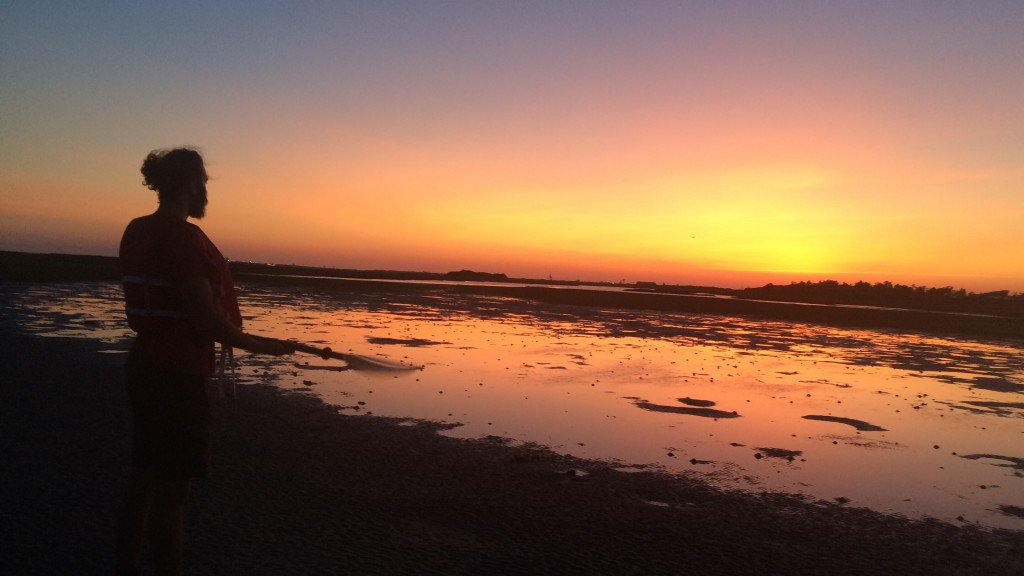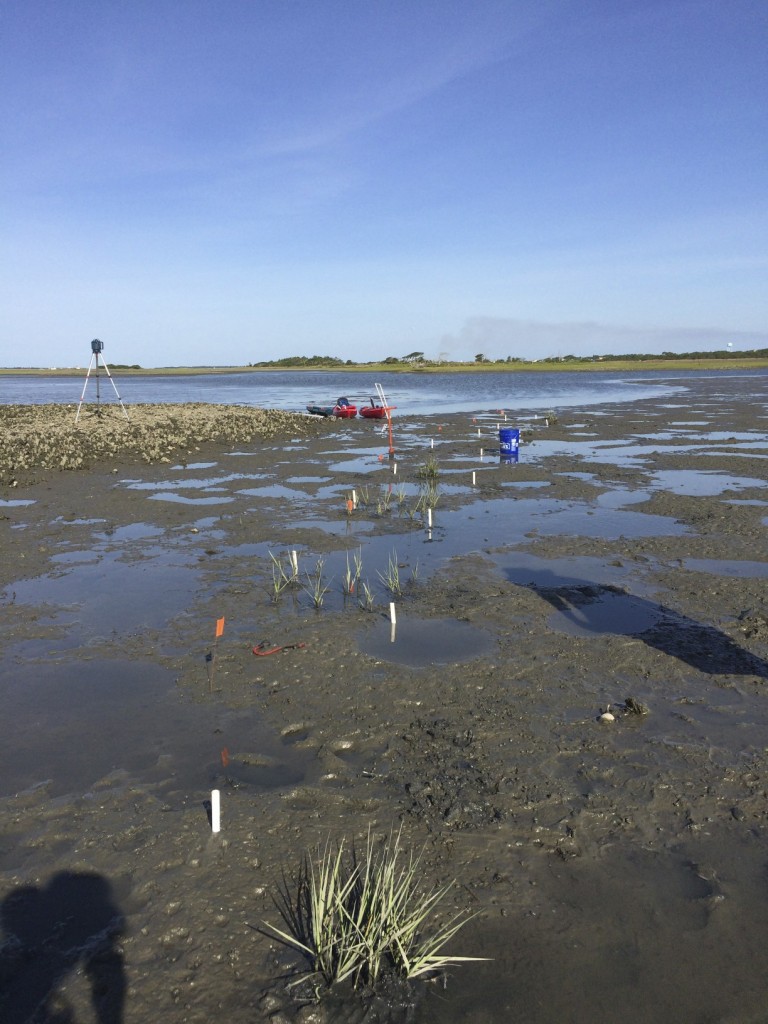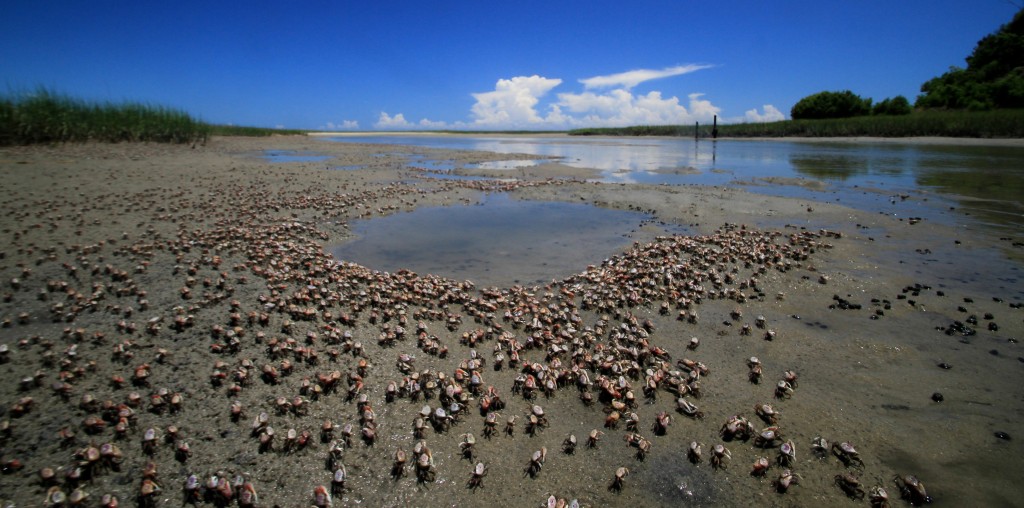What a ride! It has been an incredibly intense month with the last two days of fieldwork clocking in at 12 hours and 11.5 hours respectively. Nonetheless I can tell you that my stint as a research technician in the Silliman lab studying saltmarsh ecology has been thoroughly enjoyable and no day of Marsh life was short of an adventure.
So what is this marsh life all about? Well what it’s like is a whole lot of kayaking and a whole a lot of slopping around in shallow sandy, silty, or sticky mud flats. It means piloting around Carolina skiffs and tiptoeing gingerly around razor-sharp oyster shells (try as you may they will find a way to cut you, rest assured!). It’s also gorgeous sunsets, wild horses and just a whole a lot of time in the sun and on the water which you can’t really complain too hard about even when you’re working. But what was it all for? What was the point of all those salty sun-burnt days on the flats?
Well there were two two main thrusts of the research I worked on as part of the Silliman lab. One gets at why are salt marshes dying off. Why are these big patches of death appearing and spreading across this environment? The other is what can we do to restore them? How can we take the same resources that are being put into salt marsh restoration and make more out of them to bring more salt marsh back?
Trying to answer that first set of questions drove me to work with two real characters. The first: the man, the legend, known locally in Beaufort as alternatively “big Joe” or “crazy Joe” and the second, the ever-cheerful postdoc from China referred to simply as “Q” or “Dr. Q” because most of us Westerners butcher too badly his real name, Qiang He. Big Joe is something of an enigmatic character. Hailing from the country, and I mean the real country of Lincolnton, North Carolina, yet a true intellectual and a modern Renaissance man. Joe excels at a diversity of instruments whose names I largely can’t pronounce from regions as far-flung as Mongolia and Sri Lanka.
With these two gentlemen we established two experiments looking at the role of grazers in salt marshes in terms of competition. One experiment we situated in a little muddy salt marsh not far from Beaufort called Hoophole (which some locals crassly refer to as “Poop hole” for its reputed sewage drainage issues). In this lovely marsh we set up our experiments at the border between the dominant salt marsh grass Spartina, which much of restoration is focused on, and its competition with another taller, marsh grass, Juncus, with a nasty tendency to poke you in the eye with its long sharp blades. Dr. Silliman’s earlier work showed that despite the once conventional wisdom that herbivores in this system play essentially no important role and that competition was mediated by the plants tolerance to various physical strain, in fact the high abundances of periwinkle snails can have a huge effect on controlling marsh die-offs. Though still not completely understood, it appears that physical stressors like drought begin an initial setback to the marsh perhaps killing a handful of plants. At this point the periwinkle snails begin to concentrate and attack the stressed plants. Now what these remarkable snails do is essentially fungal farming. They use their scraping mouth parts to cut thin strips out of the marsh grass blades and all the while defecate into these holes. From these defecations sprout the spores of fungi that further breakdown the Spartina and make it digestible to the snails to return and snarffle down the degraded material which has become both more digestible and more nutritious. Though the Spartina can tolerate a degree of this going on, with a higher concentration of snails attacking the plants, they begin to die back completely. As a dead patch forms a ring of snails moves out from its edges seeking new Spartina like a tidal wave rolling across the marsh killing more and more and more plants. When the die off is big enough, the soil chemistry and consistency appears to change and it becomes inhospitable for the regrowth of marsh grass.
Now what we suspect happens is that the snails target the Spartina but have little effect on the Juncus so the Spartina dies back while the Juncus ends up expanding. At least that’s our theory. So what we did was set up cages that were half filled with Juncus and half with Spartina. Some of these plots were complete cages from which snails could be removed and their effect removed. Others were partial cages in which snails could access but we could look at what affects just having cages themselves and the last were open plot where we would monitor the effect of the grazers without any manipulation It sounds pretty basic but honestly this kind of work is what really has led to some of the greatest insights of the ecology of our planet. It’s all about asking the right questions and designing simple experiments that can truly answer them.
Now looking back “Poop Hole” was definitely fun and surprisingly scenic but the real adventure came on our long trip down to Saint Augustine, Florida. We wanted to ask a similar sort of question but on the border between the Spartina salt marsh and mangroves. So we went to the closest place that we could find a red mangrove. At a 9-hour drive it’s a bit of a long haul and even longer when you aren’t certain where you’re staying, arriving to find no one around and no one to call. We figured it out eventually though and had a week of intensive fieldwork to try and set up our sites before we ran out of time.
The experiment here was to look at whether grazers like snails and grasshoppers mediated the boundary between mangroves and marsh grass. So just like at Hoop Hole we set up cages on the border of these two species and in some excluded snails, in some included them, and in others just put up a part of a cage to see what effect it had. The big difference in set up was that we had a whole lot more cages and a whole lot less time to do it.
Nevertheless it was not without its good fun. In the evenings we explored the Guana River State Park and did some fun night walks. On these night walks we played one of my favorite games: a game called Herpolympics. The Herpolympics are of course the Olympics of spotting herps, that’s reptiles and amphibians. It’s 1 point for frogs, 3 points for a lizard, and 10 points for a snake. And I will tell you it was some pretty fierce competition! It became quite clear that fiogs were in great abundance and lizards only slightly behind. The match was close but I eventually pulled away for a 37 to to 27 to 24 victory over Joe and Q. In fairness, I have done this for years while this was Joe and Q’s first introduction to the game so I probably should have received some sort of handicap. The park also boasted a beautiful meadow filled with fireflies and an amusing abundance of armadillos one of which pranced right up to me after a scuffle with a second armadillo and I even touched before it scampered off (their eyesight is extremely poor).
We concluded this fantastic trip with a visit to the backwater country bar saltwater Cowboys overlooking the sunset on the marsh.
My other project. which. in truth. took the vast majority of my time was working with a PhD student Liz Schrack my “friend-boss”/ “boss-friend”. She tasked me to work on this project so that she could continue her fieldwork on coral reef restoration in the Caribbean and still feel certain that it would get done so I took my duties very seriously. To be honest when I accepted this position I had kind of thought she would be having a blast on coral reefs while I would be neck deep in anoxic mud smelling of methane and covered in flies. I was quite pleased to discover the reality. Who would’ve ever thought that salt marshes were actually an incredibly pleasant place to spend one time? They’re close enough to the coast to be breezy and pleasant but far enough away to not be swarming in people and thus delightfully peaceful. Moreover the water is warmer than on the beach so whenever you get too warm you can pop in for a very comfortable and leisurely lie about in the water. The best part certainly though are the sunsets. I was delighted by the opportunity to go out kayaking to Carrot Island and watch a stunning sunset reflected perfectly in the pools of marsh of water on the salt marsh.
Far more than just an excuse for me to have a good time splashing about on the salt marsh, however, this is an important experiment that Liz is conducting. The question we are asking here is how can we make the labor- and money-intensive processes of salt marsh and oyster reef restoration more efficient to bring back these valuable ecosystems. Ecologically we want to understand the importance of facilitation as well in these systems and by facilitation I mean positive interactions where the presence of another individual or another species supports the other rather than hindering it through competition.
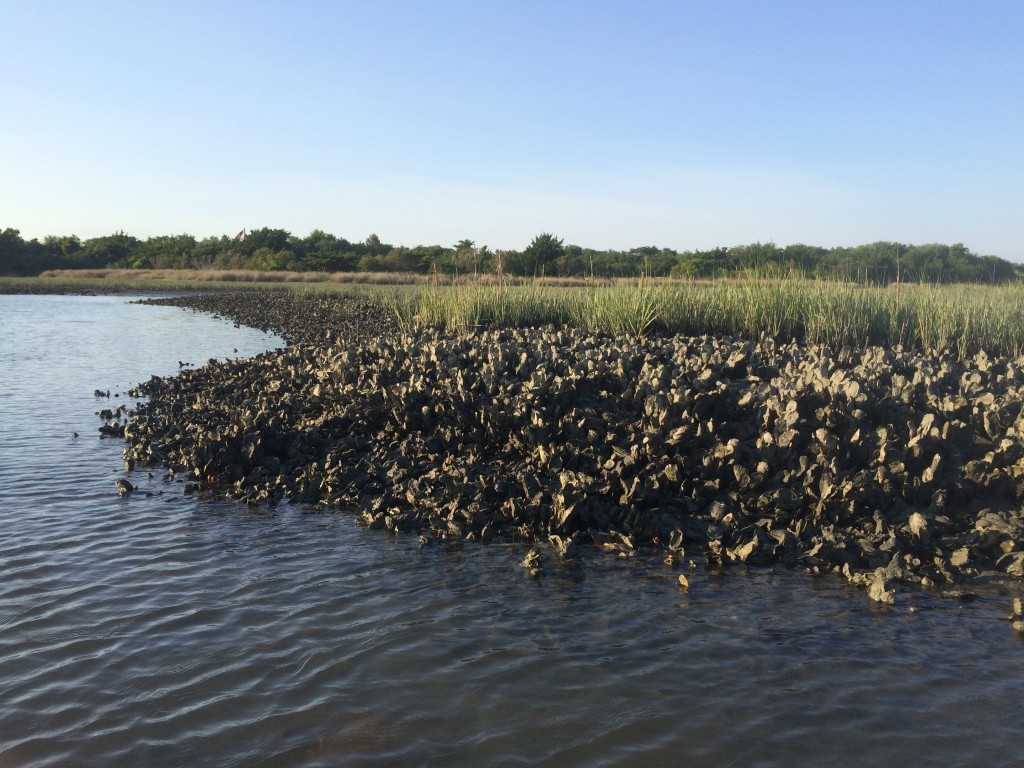
Now I realize I’ve started this post taking it for a given that people would appreciate the value of salt marsh but I should probably pause here to enumerate its virtues. Salt marshes and oyster reef are part of what referred to as “living shorelines”. It has at this point been well-documented that these living shorelines especially in conjunction with one another provide more cost-effective and more physically effective barriers to extreme weather events and wave buffering than man made structures like seawalls and sandbags. Moreover their presence does not eliminate nearby beaches by redistributing the flow of sediment like those artificial structures do. On top of that they sequester carbon and provide crucial nursery habitat for nearby fisheries rendering further economic gains to the surrounding human populations. Perhaps this is obvious as well but salt marshes at the edge of the land-sea interface or the mouth of rivers provided incredibly important service of removing the excess nitrogen and phosphorus pouring into the marine system from upstream land clearance in agriculture. In short, salt marsh and oyster reefs are incredibly important aspects of creating resilient coastal communities as well as combating climate change. Before exploring this ecosystem I had falsely assumed a trade-off of having either sandy beaches or salt marshes when in fact you can have both and they support one another: the beaches are helped put in place by salt marshes, which control the flow of sediment between them. If that’s not enough to convince you of the value of oyster reefs and salt marshes probably nothing will.
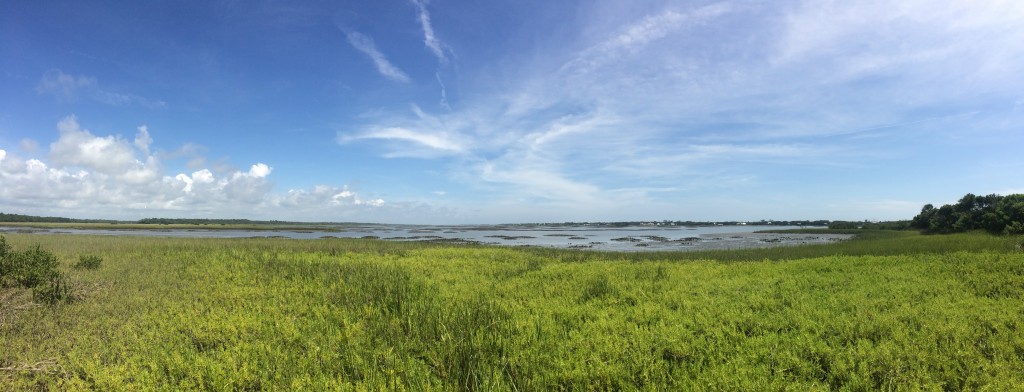
My project with Liz was looking at both the association between oysters and marsh grasses and the relationship between marsh grasses themselves. What we did was pair sites with standing oyster reefs, either natural or restored, with sites with no such protection from wave action. Then within these treatments we established plots with some more clumped together in a single point in the middle growing tightly next to one another, and others dispersed with more space in between. Conventional salt marsh restoration has often been approached in the way that we do agricultural planting with nice even rows equally spaced with plenty of room to minimize competition. But what we suspect, as in the case of many other systems when conditions are harsh, is that the role of competition becomes less and the role of facilitation (positive interactions) becomes more important. In the case of the relationship between oysters and marsh grasses we suspect that the oysters facilitate the marsh grass by sheltering them from wave action. In the case of the relationship between the marsh grasses themselves when clumped together we suspect the benefit of clumping may come from changes in soil chemistry. The soils in which marsh grass grows are almost entirely devoid of oxygen because of the respiration of dense microbial communities. Now it seems funny to think about but plant roots actually need to breathe like we do. They need oxygen to survive. So what the marsh grass does is to take O2 from above its leaves where it’s created and shunt it down into the roots. This transfer is not entirely conserved however and some of it leaks out into the surrounding soil. So the more roots there are the more friendly the environment becomes to the growth of more roots. So we suspect that if you’ve got the same number of marsh grass plugs available, if you clump them together they’re going to end up doing better then the dispersed ones which are fighting this toxic soil alone. So that’s what we set out to test.
Though it has consumed much of my last month and lead to some very long 10- to 12-hour work days, often ending at 9:30 PM with me a hot sticky mess, it has left me truly fascinated with these questions and deeply rewarded by the work that we’ve done.
What I can say qualitatively from what I’ve seen is an interesting mixture of results. Within the first few weeks the value of the protective oyster reefs was plain as day as those without oyster reef have been hit hard by wave action. At one of the sites immediately after the initial planting a tropical depression settled off the coast. The resulting storm surge caused massive damage to our experimental plants. As I replanted, because we really needed them to establish before the experiment could begin, I took data on which plants had been removed. Interestingly it appeared that those that were planted in clumps actually suffered a worse fate than those that were disbursed. This may be because in a clump there is comparably less surface area per grass for the roots to penetrate the surrounding soil with many roots making their way into the nearby grass plugs with the end result that the entire group could simply be ripped out of the marsh. This effect is far more noticeable when not protected by oyster reefs. What I can also say after about three weeks of growth is that it at least appears that despite initial setbacks the clumped marsh grasses are doing better as they have a higher density of stems and they just look plain healthier.
There is, however, one “wild card” aside from hurricanes. That wildcard is the population of feral horses that roams freely across Carrot Island. Now, at great risk of rubbing some people the wrong way, I will restrain my opinion of these rather destructive creatures which my father fondly refers to as “dimwitted herbivores” (his views do not necessarily reflect my own, mind you). Introduced to the island sometime ago they have done untold amounts of damage to the native flora. They continue doing that damage unfortunately on our experiment. Recently my fieldwork has added a new data column for horse grazing and I’m a little frustrated to point out that actually it appears like they prefer grazing on the clumps. So we essentially have a third treatment to add to our experiment. We have two sites that have horse-grazing and one site on the mainland which has none. So it may well turn out the clumping marsh grasses is really the most effective but only provided you have an oyster reef and no mega-herbivores like horses. This of course would be an interesting results but perhaps not the clear picture that we were hoping for.
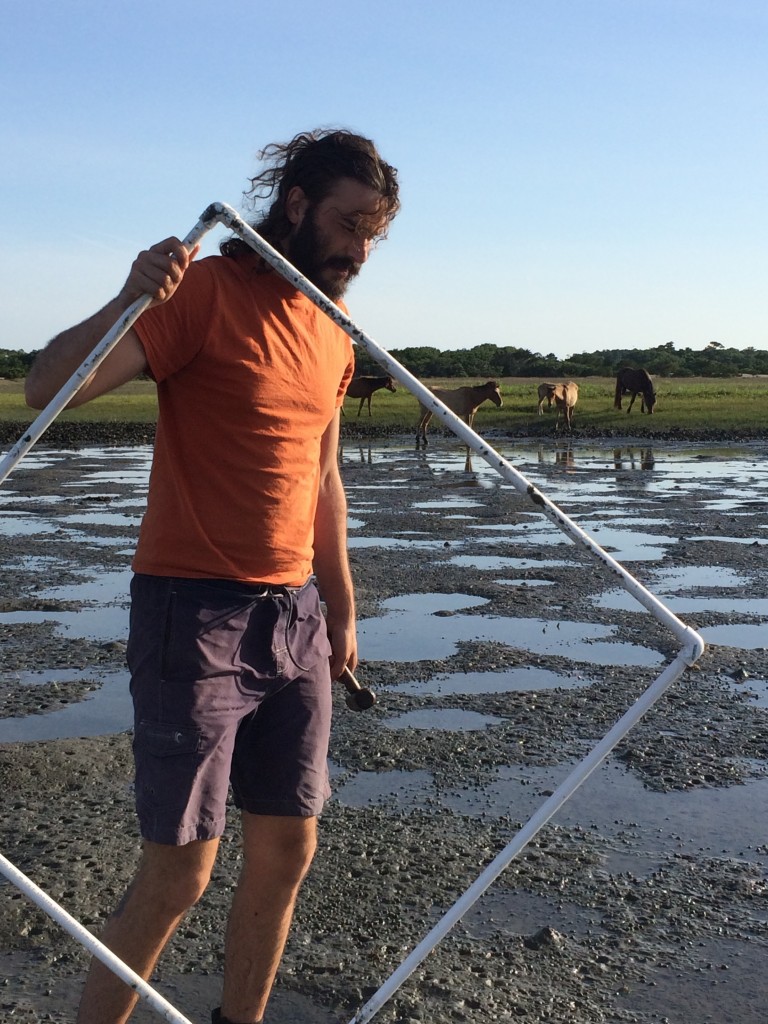
As I finish this blog I look back fondly on these intense last four weeks. My kayaking muscles have never been in such good shape and the odd bits of the back of neck and top of leg that I always forget to apply sunscreen to have never been so tan. I’m already settling into a very different (though almost intense life) in Central California diving in the kelp forest but I very much look forward to hearing how these projects turn out.
Fingers crossed that the whole thing isn’t trumped by hurricanes or horses!
For more pictures of the experiments and the lab’s work in general check out the #Sillimanlab hashtag on Instagram. Or to learn more about the Silliman lab and what they do check out http://www.sillimanlab.com/




